Comme souvent lorsqu’on travaille sur le trottoir, la préparation d’une intervention pour JCDecaux a été l’occasion d’une amusante découverte : « la parade de l’ombre » ou un ballet des parasols sur un trottoir de West Palm Beach en Floride ! Poétique et ludique !
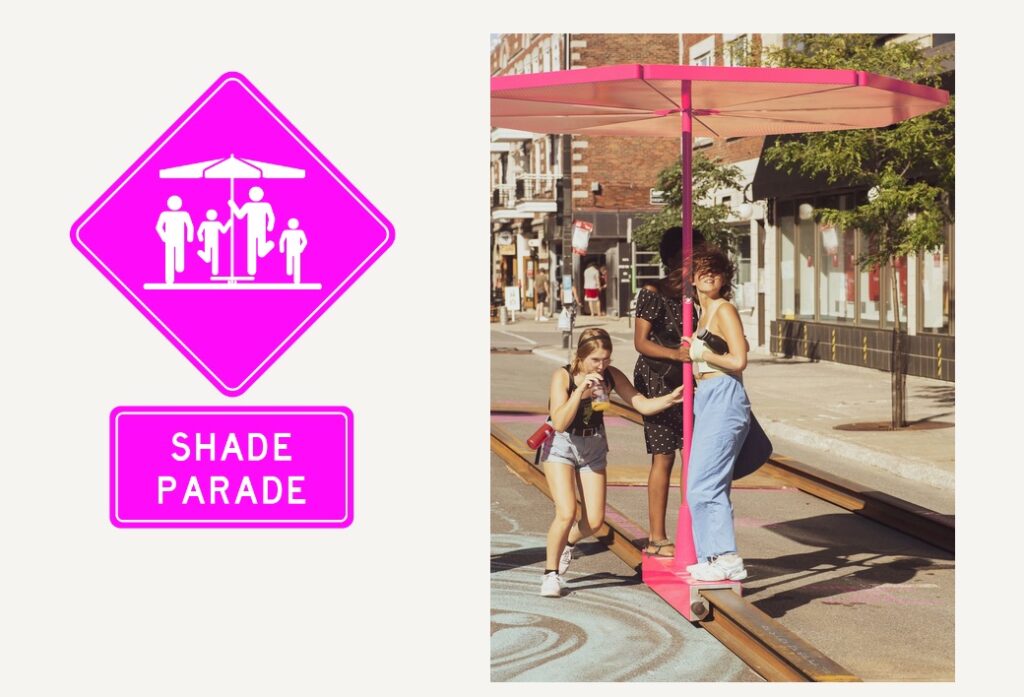
Comme l’écrit Daily Tous les jours :
Cities designed primarily for cars have many endless and shadeless sidewalks unfavorable or hostile to pedestrians. This has repercussions not only on mobility, but on equity and wellbeing. When given such a monotonous and exposed sidewalk to work with in West Palm Beach, the issue became an opportunity for play and collaboration. Shade Parade is a slow means of public transportation inviting passersby to glide oversized parasols along a rail to negotiate and gather in delightful ways.
Traduction (en partie via Google Translate) :
Les villes conçues avant tout pour les voitures comportent de nombreux trottoirs interminables et sans ombre, défavorables ou hostiles aux piétons. Cela a des répercussions non seulement sur la mobilité, mais aussi sur l’équité et le bien-être. Lorsqu’il nous a été donné un trottoir aussi monotone et exposé à West Palm Beach, le problème est devenu une opportunité de jeu et de collaboration. Shade Parade est un moyen de transport public lent invitant les passants à faire glisser des parasols surdimensionnés le long d’un rail pour négocier et se rassembler de manière agréable.
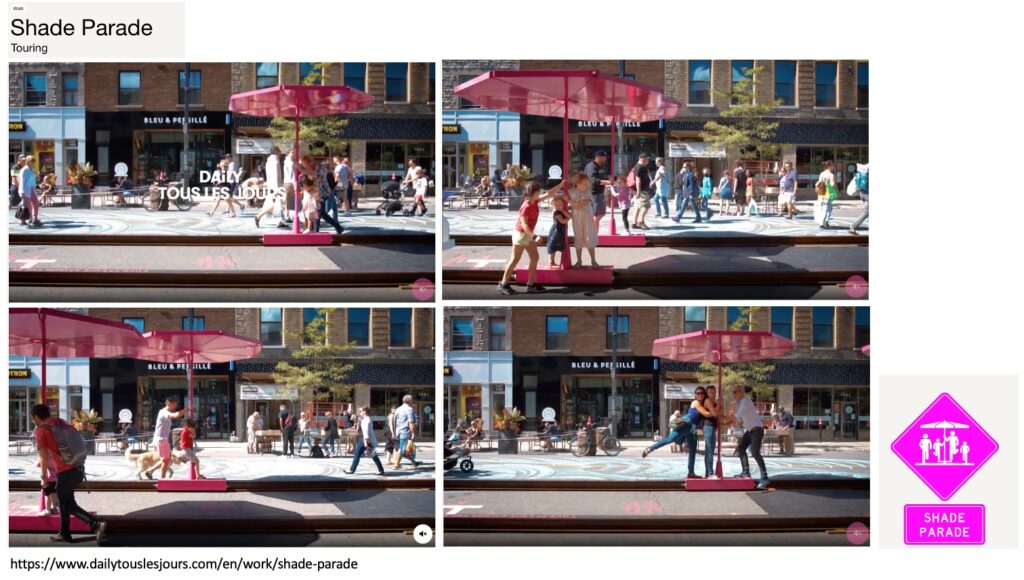
Pour voir la vidéo, c’est : ici.
Hasard ? L’écart (de température) peut sembler grand avec notre précédent billet sur la neige à Montréal, mais… les artistes à l’origine de cette installation sont québécoises !
A lire également :
– l’article du New-York Times cité à propos de cette installation : « ‘Turn Off the Sunshine’: Why Shade Is a Mark of Privilege in Los Angeles« . Extraits :
« Shade in Los Angeles sits at the intersection of two crises: climate change and income inequality. City officials are rushing to deploy cover to hundreds of bus stops and plant 90,000 trees ». (…) They say the sun has always been the draw of Los Angeles, but these days, shade is increasingly seen as a precious commodity, as the crises of climate change and inequality converge. (…) “Maybe you haven’t thought about it this way, but shade is an equity issue,” Mayor Eric M. Garcetti said at a recent event on a blazing hot day in South Los Angeles, where he discussed a number of climate initiatives around the city, including creating more shade.
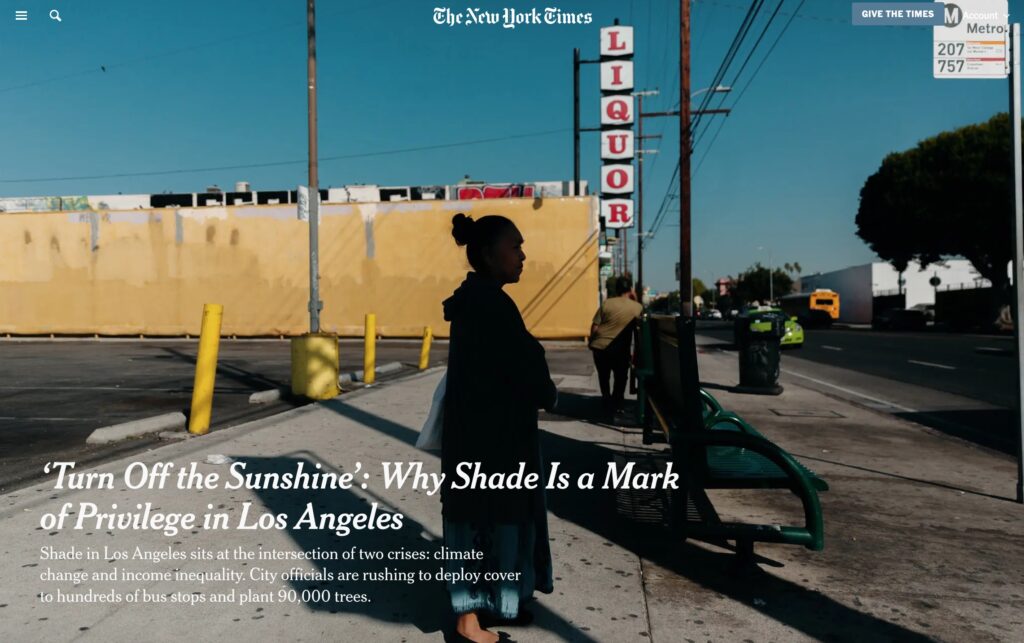
– l’article « Shady democracy: shelter from the sun is a public resource », de Lesley Lokko, dans The Architectural Review du 4 avril 2020 (en bas de ce billet sur les trottoirs des Champs Elysées… quoique l’article concerne l’Afrique). Extraits :
The OED’s primary definition of ‘shade’ is ‘comparative darkness and coolness caused by shelter from direct sunlight’. In African cities from Kinshasa to Khartoum, trees are the primary source of shade, providing not only respite from the blinding light but also from the heat. In places where the midday temperature can rise to over 40°C, the chance to sit – even for 10 minutes – under a neem tree is more than simply welcome: it is essential. (…) Shade is not regulated: it is accidental, democratic, public-spirited. In a neat reversal of planning methodologies, these clusters of urban and public activity spring up simply where shade can be found. No one remembers who planted the trees, or indeed to whom they might ‘belong’. Trees are ubiquitous and, thanks largely to the climate, require little maintenance. (…) In recent years, however, accompanying the rapid and explosive urbanisation patterns across Africa, shade has increasingly become under attack. This war on shade is fuelled on the one hand by rising land values, and on the other, weak planning governance. »
– le rapport « Paris à 50°C »
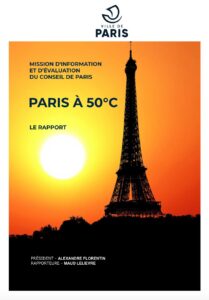
– l’article du Monde du 23 juillet 2023 : « Coup de chaleur sur la ville de Lyon« , de Stéphane Mandard, Richard Schittly, Laetitia Van Eeckhout et Juliette Garnier, qui permet notamment de simuler des solutions pour diminuer la température de sa rue (ci-dessous : « structures d’ombrage » versus fontaines).
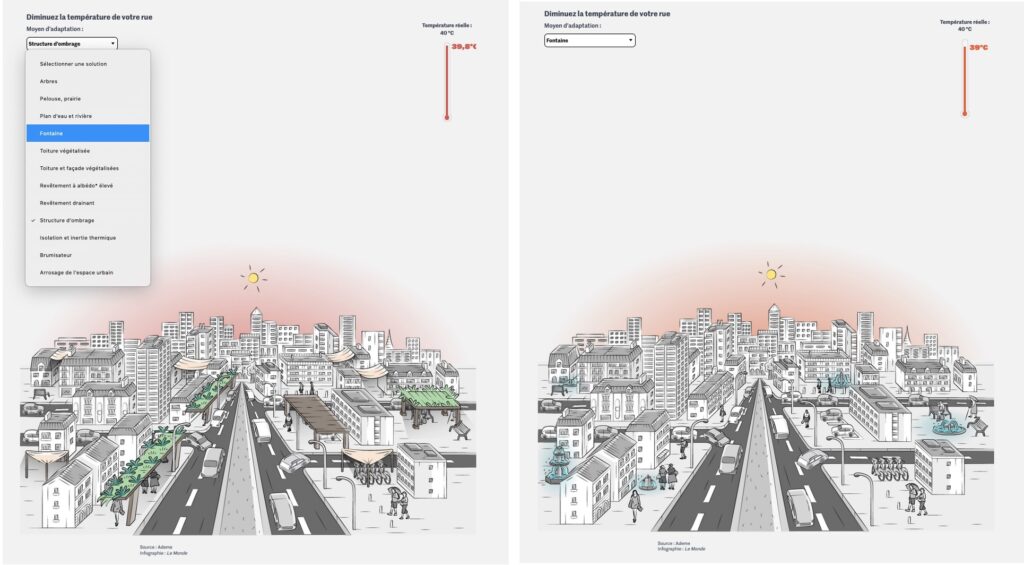
Et aussi : le fameux « ballet du trottoir » de Jane Jacobs et ses enjeux de traduction.
Ajour de mars 2025 : « Déneigement, ombre : quels services locaux dans les villes réchauffées ? » est désormais une chronique prospective dans Futuribles.


